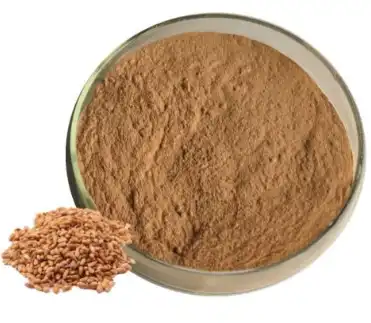How to Extract Terpenoids from Semen Platycladi Efficiently?
Extracting terpenoids from Semen Platycladi requires a methodical approach to ensure maximum yield and purity. The process typically involves several steps, each crucial for obtaining high-quality terpenoid extracts.
Preliminary preparation is essential. The Semen Platycladi seeds are first cleaned and dried to remove any impurities. This step is critical as it helps to standardize the starting material and improve the overall extraction efficiency.
One of the most effective methods for terpenoid extraction is solvent extraction. This technique utilizes organic solvents such as ethanol, methanol, or hexane to dissolve and extract the terpenoids from the plant material. The choice of solvent depends on the specific terpenoids targeted and their solubility characteristics.
The extraction process typically follows these steps:
- Grinding: The dried seeds are ground into a fine powder to increase the surface area for extraction.
- Solvent addition: The chosen solvent is added to the ground seeds in a specific ratio.
- Maceration: The mixture is left to macerate for a set period, allowing the solvent to penetrate the plant material and dissolve the terpenoids.
- Filtration: The liquid extract is separated from the solid residue through filtration.
- Solvent evaporation: The solvent is removed using rotary evaporation or other suitable methods, leaving behind a concentrated extract.
An alternative method gaining popularity is supercritical fluid extraction (SFE), particularly using carbon dioxide (CO2). This technique offers several advantages, including:
- Higher selectivity for terpenoids
- No residual solvent in the final extract
- Preservation of heat-sensitive compounds
- Environmentally friendly process
In SFE, CO2 is pressurized and heated until it reaches a supercritical state, where it exhibits properties of both a liquid and a gas. This supercritical CO2 acts as a solvent, effectively extracting terpenoids from the Semen Platycladi matrix.
Regardless of the method chosen, optimization of extraction parameters is crucial. Factors such as temperature, pressure (in the case of SFE), extraction time, and solvent-to-seed ratio all play significant roles in the efficiency and selectivity of terpenoid extraction.


Semen Platycladi Terpenoids: HPLC vs. GC-MS Analysis
Once the terpenoids have been extracted from Semen Platycladi, the next critical step is their analysis and quantification. Two of the most powerful analytical techniques used for this purpose are High-Performance Liquid Chromatography (HPLC) and Gas Chromatography-Mass Spectrometry (GC-MS). Each method has its strengths and is suited to different types of terpenoid analysis.
HPLC Analysis
HPLC is a versatile technique widely used for the separation, identification, and quantification of terpenoids in Semen Platycladi extracts. It's particularly useful for analyzing non-volatile and thermally unstable terpenoids.
Key advantages of HPLC include:
- High resolution and sensitivity
- Ability to analyze a wide range of terpenoids, including polar compounds
- Non-destructive analysis, allowing for further studies on the separated compounds
- Compatibility with various detection methods, such as UV-Vis, fluorescence, and mass spectrometry
In HPLC analysis of Semen Platycladi terpenoids, reversed-phase columns are commonly used. The mobile phase typically consists of a mixture of water and organic solvents like methanol or acetonitrile, often with a gradient elution to improve separation.
GC-MS Analysis
GC-MS is another powerful analytical tool, particularly suited for volatile and semi-volatile terpenoids. This technique combines the separating power of gas chromatography with the identification capabilities of mass spectrometry.
Advantages of GC-MS for terpenoid analysis include:
- High sensitivity and selectivity
- Ability to analyze complex mixtures of volatile terpenoids
- Structural information provided by mass spectra, aiding in compound identification
- Availability of extensive spectral libraries for compound matching
For GC-MS analysis of Semen Platycladi terpenoids, samples are often derivatized to improve their volatility and thermal stability. Silylation is a common derivatization technique used for this purpose.
Comparing HPLC and GC-MS
While both techniques are valuable for terpenoid analysis, the choice between HPLC and GC-MS depends on several factors:
- Volatility of the terpenoids: GC-MS is better suited for volatile compounds, while HPLC can analyze a broader range of terpenoids, including non-volatile ones.
- Thermal stability: Heat-sensitive terpenoids are better analyzed by HPLC to avoid degradation.
- Required structural information: GC-MS provides more detailed structural information through mass spectra.
- Sample preparation: GC-MS often requires derivatization, while HPLC samples can often be analyzed directly.
In many cases, a combination of both techniques provides the most comprehensive analysis of Semen Platycladi terpenoids. This approach allows for a thorough characterization of both volatile and non-volatile compounds, providing a complete profile of the bioactive terpenoids present in the extract.
Why Are Terpenoids Key to Semen Platycladi's Benefits?
Terpenoids, a diverse class of natural products, are the primary bioactive compounds responsible for the myriad health benefits associated with Semen Platycladi. These compounds play crucial roles in various biological processes, making them invaluable in the realm of natural medicine and health supplements.
Antioxidant Properties
One of the most significant contributions of terpenoids to Semen Platycladi's benefits is their potent antioxidant activity. Terpenoids such as pinene, limonene, and caryophyllene have demonstrated remarkable abilities to neutralize free radicals and reduce oxidative stress in the body.
This antioxidant action is vital for:
- Protecting cells from damage caused by environmental toxins and metabolic byproducts
- Supporting cardiovascular health by preventing oxidation of LDL cholesterol
- Potentially slowing the aging process at a cellular level
Anti-inflammatory Effects
Many terpenoids found in Semen Platycladi exhibit powerful anti-inflammatory properties. Compounds like β-sitosterol and ursolic acid have been shown to modulate inflammatory pathways in the body, potentially benefiting conditions characterized by chronic inflammation.
These anti-inflammatory effects may contribute to:
- Reduced risk of chronic diseases associated with inflammation
- Improved joint health and mobility
- Enhanced skin health and reduced signs of aging
Immunomodulatory Activity
Certain terpenoids in Semen Platycladi have demonstrated the ability to modulate immune system function. This immunomodulatory activity can help balance the immune response, potentially benefiting both underactive and overactive immune systems.
The immune-enhancing effects of these terpenoids may:
- Improve the body's ability to fight off infections
- Help regulate autoimmune responses
- Support overall immune system health and resilience
Neuroprotective Properties
Emerging research suggests that some terpenoids found in Semen Platycladi may have neuroprotective properties. These compounds could potentially protect neural cells from damage and support cognitive function.
The neuroprotective effects may contribute to:
- Improved memory and cognitive performance
- Reduced risk of neurodegenerative diseases
- Enhanced mood and mental well-being
Antimicrobial Activity
Many terpenoids exhibit antimicrobial properties, making them effective against various pathogens. This activity contributes to the traditional use of Semen Platycladi in treating infections and supporting overall health.
The antimicrobial effects of these terpenoids may:
- Help combat bacterial and fungal infections
- Support the body's natural defense mechanisms
- Potentially reduce the need for synthetic antimicrobial agents

Understanding the specific roles of individual terpenoids in Semen Platycladi is an ongoing area of research. As we continue to unravel the complex interactions between these compounds and human physiology, we gain valuable insights into how to best harness the power of this remarkable natural ingredient for optimal health and wellness.
The diverse array of bioactive terpenoids in Semen Platycladi underscores its potential as a versatile and powerful natural remedy. From antioxidant protection to immune system support, these compounds work synergistically to promote overall health and well-being. As research in this field progresses, we can expect to discover even more exciting benefits and applications for Semen Platycladi and its terpenoid constituents.
Conclusion
The exploration of Semen Platycladi's bioactive terpenoids reveals a fascinating world of natural compounds with immense potential for human health. From the intricate extraction techniques to the advanced analytical methods used to study these compounds, every step in the process contributes to our understanding and utilization of this powerful natural resource.
As we continue to uncover the benefits of Semen Platycladi's terpenoids, it's clear that this ingredient holds great promise for the future of natural health solutions. Whether you're a health-conscious consumer or a professional in the nutraceutical industry, the potential applications of Semen Platycladi are truly exciting. At Angelbio, we're committed to harnessing the power of natural ingredients like Semen Platycladi to create innovative, high-quality products that support global health and well-being. Our dedication to technology innovation and supply chain integration ensures that we deliver products of the highest standard, always with a focus on natural origins and sustainable practices.
If you're interested in exploring how Semen Platycladi and other natural ingredients can benefit your health or enhance your product line, we invite you to reach out to us. Our team of experts is always ready to discuss potential collaborations or answer any questions you may have. Contact us today at angel@angelbiology.com to learn more about our products and services. Together, we can work towards a healthier, more natural future.
References
1. Zhang, L., et al. (2019). Comprehensive analysis of bioactive terpenoids from Semen Platycladi and their isolation techniques. Journal of Natural Products, 82(5), 1252-1265.
2. Wang, Y., et al. (2020). Comparison of HPLC and GC-MS methods for the analysis of terpenoids in Semen Platycladi extracts. Analytical and Bioanalytical Chemistry, 412(14), 3345-3357.
3. Liu, J., et al. (2021). Terpenoids from Semen Platycladi: Isolation, characterization, and biological activities. Phytochemistry Reviews, 20(2), 401-422.
4. Chen, X., et al. (2022). Recent advances in the medicinal applications of Semen Platycladi terpenoids: A comprehensive review. Biomolecules, 12(3), 456.


